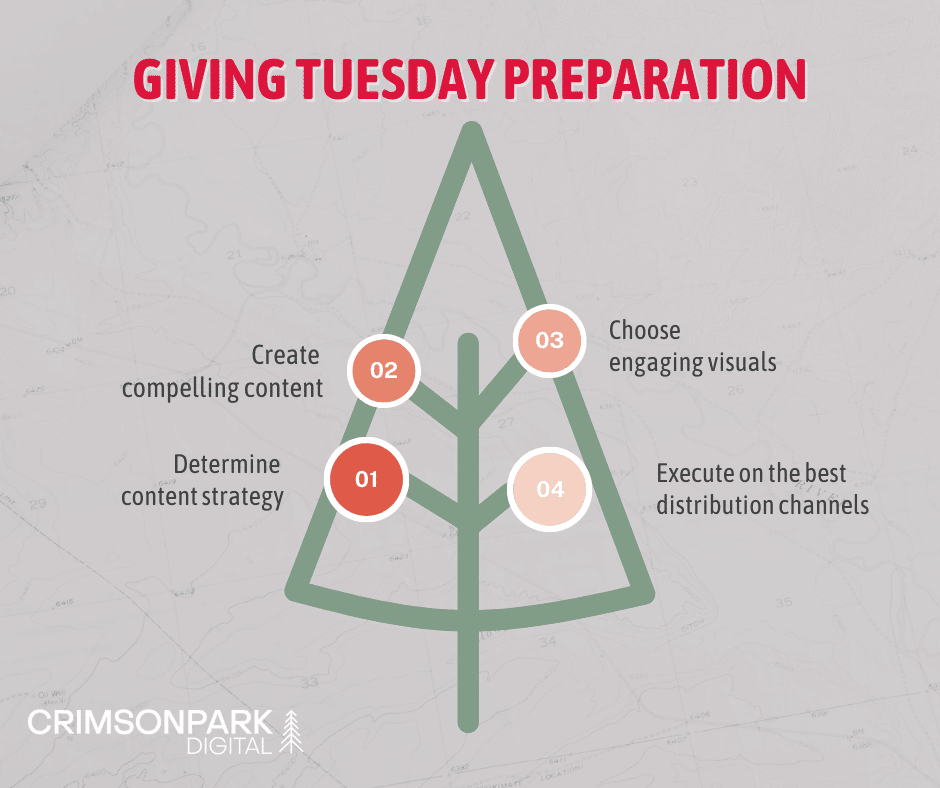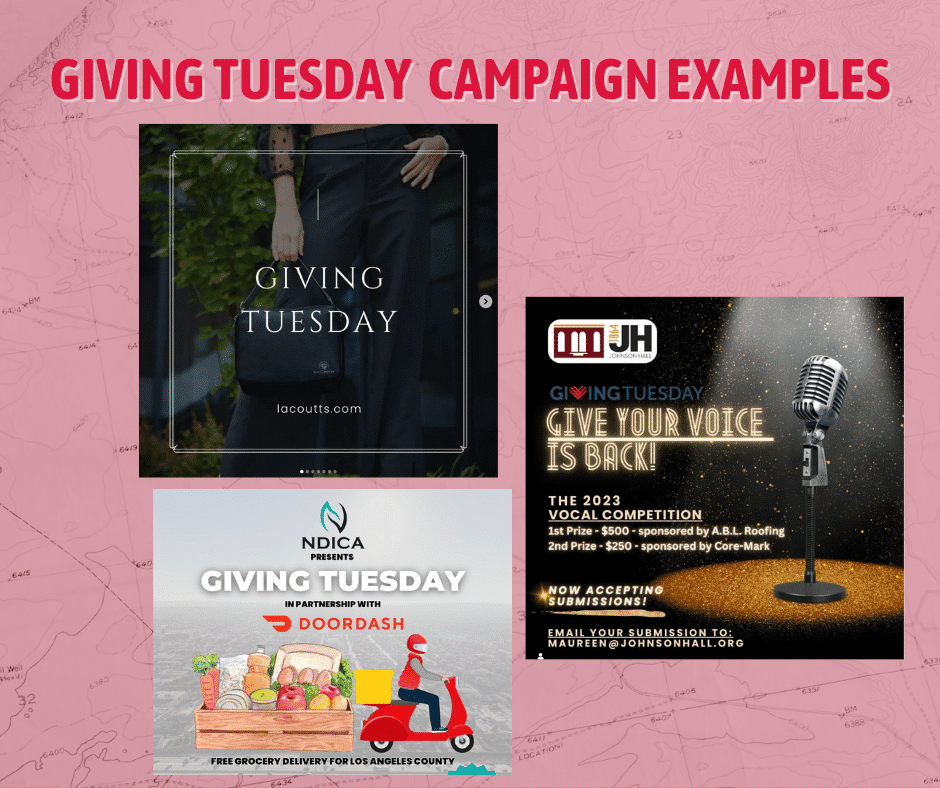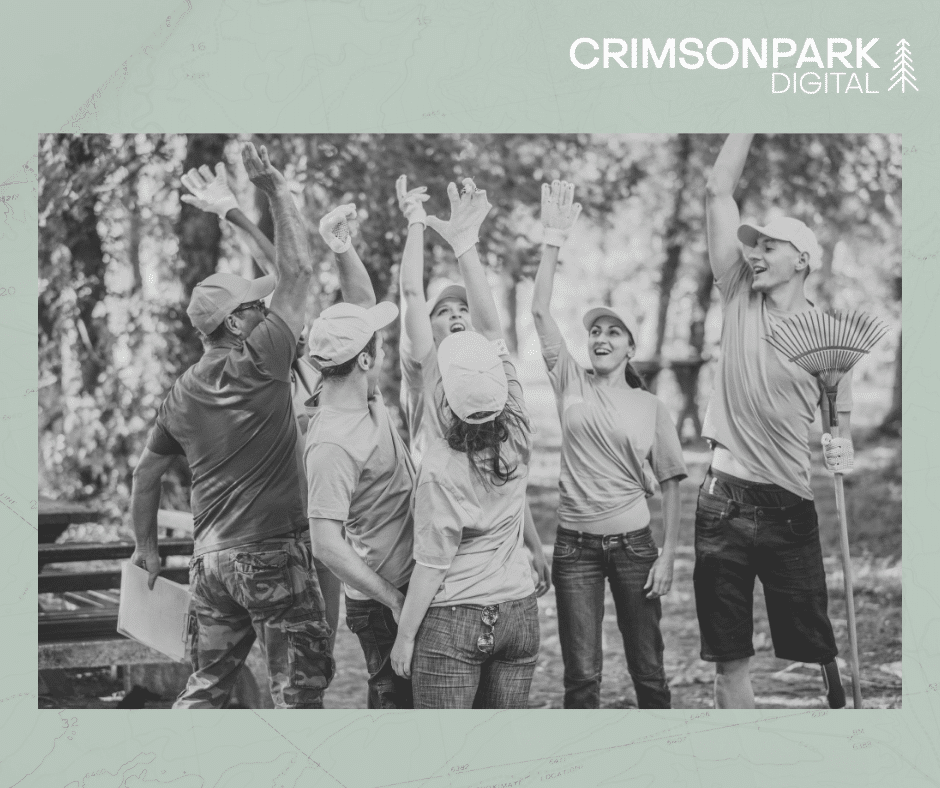Giving Tuesday Ideas for Nonprofits: 4 Steps to Stand-Out
Nonprofits, get ready. Giving Tuesday is coming up fast; this year it is on November 28, 2023. Because of Giving Tuesday’s popularity, standing out from the crowd digitally is crucial. As the digital landscape becomes increasingly cluttered, especially during the holiday season, nonprofits and businesses alike are challenged to capture attention and inspire action. This is why content marketing for Giving Tuesday can invoke impressive results.
Crafting compelling narratives, showcasing impactful stories, and leveraging various content formats enables organizations to cut through the noise and connect with their audiences in meaningful ways. Giving Tuesday content marketing campaigns aren’t just about promoting a cause; they are about generating an emotional resonance that drives individuals to contribute, volunteer, and make a difference on this significant day of giving.
What is Giving Tuesday?
Giving Tuesday holds immense significance for nonprofit organizations and community engagement. As a global movement, it’s a day dedicated to generosity and selflessness, harnessing the collective power of individuals, communities, and organizations to create positive change.
Established as a response to the consumer-focused days following Thanksgiving, Giving Tuesday serves as a beacon of hope and goodwill. Its purpose goes beyond simply giving; it’s about rallying people around causes they care about and inspiring acts of kindness. Over the years, Giving Tuesday has witnessed remarkable growth, with a surge in donations and charitable initiatives.
Last year, Giving Tuesday shattered previous donation records, resulting in $3.1 billion in financial contributions in the United States. This amount was a 21% increase in donations from the year before – and doesn’t even take into account the impact of volunteers donating their time, voices, and material items.
Nonprofit organizations should participate in Giving Tuesday in some way – whether that’s through donation drives, volunteer gatherings, or partnerships with other organizations.
Step 1: Preparing a Giving Tuesday Content Strategy
Preparing your content strategy for Giving Tuesday is a pivotal step in ensuring that your efforts resonate with your audience and drive meaningful results. A well-crafted strategy begins with a clear understanding of your goals and objectives.
Here are some examples of Giving Tuesday goals and objectives:
- Aim to raise a specific amount of funds
- Increase volunteer participation
- Hold an event for volunteers to attend that has a clear impact
Defining an objective provides a roadmap for your content creation process. It enables you to tailor your messaging and calls to action (CTAs) in a way that aligns with your overarching purpose for the day.
Equally important is identifying your target audience and understanding their interests. Delve into demographic data, online behavior, and past interactions to uncover what resonates most with your supporters. You can find this information by conducting an audience audit of your existing branded channels.
This insight allows you to tailor your content to their preferences, ensuring that it captures their attention and encourages engagement. Whether your audience is more responsive to heartwarming stories, data-driven impact reports, or interactive challenges, content customization to their preferences boosts the likelihood of meaningful interactions.
Supporting Your Organization’s Values
Aligning your Giving Tuesday content with your brand’s values and mission is the cornerstone of authenticity and resonance. Your content should reflect not only the cause you’re supporting but also the core ethos of your organization. This will build trust with your audience and emphasize the genuine commitment behind your initiatives.
Whether you’re a nonprofit, a small business, or a large corporation, showcasing your dedication to the cause through consistent messaging and storytelling reinforces your brand’s identity and strengthens its impact.
In essence, the preparation phase of your content strategy sets the tone for your Giving Tuesday campaign. It enables you to craft content that is purpose-driven, audience-focused, and authentic to your brand.
Consider each piece of content an opportunity to connect, inspire, and make a lasting impression on your supporters. Crafting a strategy in this way will enable your organization to stand out and also make a meaningful difference on Giving Tuesday.
Step 2: Crafting Compelling Giving Tuesday Content
Crafting compelling content for Giving Tuesday involves combining captivating visuals and emotional resonance to connect with your audience on a deep level. The following are two approaches to content types for this philanthropic holiday.
Appealing to Emotions
One powerful approach to Giving Tuesday content involves creating emotionally resonant stories that tug at heartstrings. Sharing narratives that demonstrate the issues your philanthropy is seeking to help solve will build a sense of urgency and connection, motivating individuals to participate. One classic example of this content theme is the iconic ASPCA campaign featuring videos from animal shelters with Sarah McLachlan’s “Angel.”
URGENT: While our team continues to provide critical care to nearly 150 rescued animals, we need the support from compassionate people like you. 🧡 Please rush a donation today to help us continue our lifesaving work and save more lives. https://t.co/nYKzYZo4ZF pic.twitter.com/MjVPmodXtA
— ASPCA (@ASPCA) August 16, 2023
Demonstrating First-Hand Impact
Real-life testimonials and case studies further amplify your content’s authenticity. Sharing the personal experiences of individuals who have benefited from your organization’s efforts humanizes your cause and reinforces the tangible change that can result from donations or involvement. These stories serve as potent reminders that a contribution of any amount can create a significant impact. When potential donors or supporters see real people benefiting from their actions, they are more likely to feel emotionally invested in your cause.
Step 3: Choosing Giving Tuesday Content Visuals
In the realm of visual content, design plays a pivotal role in capturing attention. Visuals should be attention-grabbing and resonate with the mission of your cause. Whether it’s through impactful imagery, striking typography, or strong color schemes, your visuals should mirror the emotional core of your message, instantly conveying the importance of Giving Tuesday.
Incorporating videos takes your content strategy a step further by offering a dynamic and immersive storytelling medium. Videos allow you to convey your message succinctly and compellingly.
Giving Tuesday video content examples include:
- A heartwarming narrative
- A behind-the-scenes look at your organization’s efforts
- A visual or graphic representation of the impact you’re making
By weaving strong visuals with compelling content intentions, you tap into the power of empathy and connection. The goal is to leverage attention-grabbing content that captures your audience’s attention and holds it long enough to deliver your message.
Step 4: Giving Tuesday Content Distribution Channels
In the world of digital philanthropy, creating compelling content is only half the battle. To truly make an impact on Giving Tuesday, your carefully crafted messages need a robust distribution strategy – to make sure they reach the right people, at the right time, to make a difference.
There are many different digital channels and avenues to consider using for Giving Tuesday content distribution, including:
Social Media Channels
Social media platforms offer a dynamic space for Giving Tuesday content distribution, where innovative strategies can drive engagement. Incorporating “gamification” can be a fun way to encourage contributions.
Polls and challenges turn giving into interactive experiences, fostering a sense of community. Team-based efforts encourage collaborative giving, amplifying impact through collective action.
Additionally, partnering with other organizations (nonprofit or for-profit) and influencers can inspire participation. Contests can motivate supporters to share their progress, and result in UGC for your organization.
Email Marketing Campaigns
Email marketing campaigns serve as a direct and personalized channel for Giving Tuesday content distribution. Infuse emails with compelling narratives that inspire action, share success stories, showcase the real-world impact of past contributions, and foster emotional connections. Highlight the urgency of the mission to encourage immediate engagement.
Email lists can be segmented based on donor history, interests, and engagement level, with content tailored to each group to maximize relevance and increase the likelihood of donations.
Incorporate countdowns and progress updates to build urgency for the Giving Tuesday campaign. Subject lines should ignite curiosity and resonate emotionally.
The Organization’s Blog or Website Landing Pages
Craft in-depth articles that delve into the heart of your cause, share the stories of individuals who have benefited from past contributions, and showcase the tangible results of giving on your organization’s blog. Through detailed narratives, readers connect emotionally, making them more likely to contribute.
Consider creating dedicated landing pages that serve as hubs of information for Giving Tuesday. Include compelling calls to action, contribution or volunteer progress trackers, and links to other campaigns or channels. These pages offer a centralized location for visitors to learn, engage, and take action.
Paid Advertising
Paid digital ads are another avenue for getting your organization’s message in front of a large number of people. Google Ads has a program for nonprofits that grants up to $10,000 in covered advertising costs that helps raise awareness, attract donors, and recruit new volunteers using Google search ads. These ads can target specific audiences and keywords to guarantee they reach people specifically seeking to make a difference.
The best channel to distribute Giving Tuesday content through will vary based on the organization, its campaign, and its goals. A combination of channels is recommended as the most effective way to maximize reach, resulting in more contributions.
Content Marketing for Giving Tuesday Impact
As Giving Tuesday approaches, the challenge to stand out in a saturated digital environment is more pressing than ever. Content marketing for Giving Tuesday is the key to truly connecting with your audience and making a lasting impact. It’s about crafting narratives that resonate deeply, sharing real stories of change, and embracing visuals that evoke emotion.
It’s through an orchestrated content creation and distribution effort that your organization will turn awareness into action to embrace Giving Tuesday.
Our comprehensive content marketing service covers campaign creation from start to finish. From audience research, messaging development, graphic design, and distribution strategy, we can develop a Giving Tuesday campaign that aligns with your organization.
Frequently Asked Questions
When is Giving Tuesday in 2023?
This year, Giving Tuesday will be held on Tuesday, November 28, 2023. Giving Tuesday first began in 2012 and has occurred on the Tuesday after Thanksgiving for 11 years.
What are some Giving Tuesday ideas for nonprofits?
Nonprofit organizations should develop compelling content marketing strategies that drive engagement and donations to their mission. Some ideas include telling heartwarming stories, demonstrating the impact of the organization or effort, and behind-the-scenes looks at the nonprofit’s inner workings.
Can for-profit companies participate in Giving Tuesday?
For-profit organizations can participate in Giving Tuesday and it is a great idea to partner with a charitable organization. Additionally, companies can encourage their employees to work together or compete with one another in order to increase engagement and the philanthropic impact.



